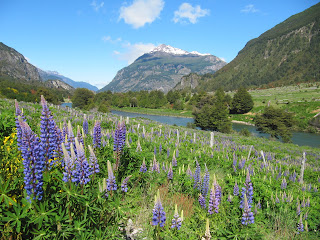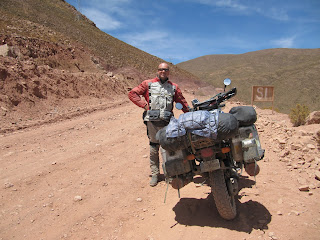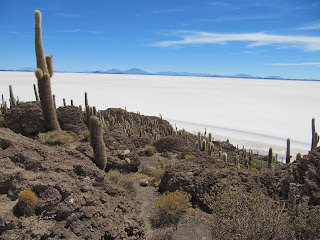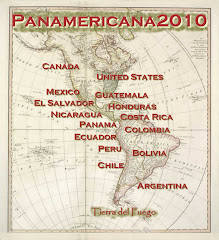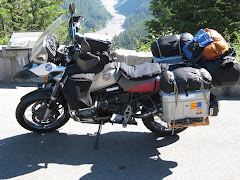Hem arrivat a Ushuaia, a la fi del mon! Ja us ho contem ben aviat...per ara aqui teniu la foto!
22/11/2010
Ushuaia!!!!
We made it to Ushuaia, the end of the world! More to follow soon...for now here is the proof!
Hem arrivat a Ushuaia, a la fi del mon! Ja us ho contem ben aviat...per ara aqui teniu la foto!
Hem arrivat a Ushuaia, a la fi del mon! Ja us ho contem ben aviat...per ara aqui teniu la foto!
19/11/2010
Chile and Argentina / Xile i Argentina
And so while driving along surrounded by volcanoes we found ourselves in Chile, and the first thing that hit us was how clean and tidy the country was and how well behaved the drivers were, a pleasant change from Bolivia and their Peruvian neighbours.
I mentre conduïm entre volcans ens trobem que som a Xile, i el primer que ens sobte es que net es el pais i que be condueixen, un bon canvi venint de Bolívia i del seu veí Perú.
After two days into the country we both thought Dan Walsh, the motorcycle journalist really nailed it when he said Chile was like a supermodel: long, very thin, way to expensive to maintain and just a little bit boring! (...well, the northern half anyway). After 3 days of driving through desert and looking at nothing but sand and with boredom levels reaching melt down point we reached the capital Santiago for a few days rest after the Bolivian experience and the desert heat.
Desprès de dos dies al país vam pensar en la frase que el Dan Walsh, el periodista motorista esmena quan en el seu moment va escriu sobre Xile dient que es com una supermodel: llarga, prima, molt cara de mantenir i una miqueta avorrida! (...be, a menys la part del nord). Desprès de 3 dies de travessar desert , tot sorra i amb el nivells d’avorriment a tope arribem a la capital Santiago per uns quans dies i per poder descansar desprès de la experiència Boliviana i la calor del desert.
After that we headed south where things started to get greener and a little more interesting. Soon after we took a left turn and headed for the Argentinian border through beautiful mountanous pass via the Nahuel Huapi National Park. It was strange driving on a road and feeling quite cold with snow all along the edges when just a few days before we were driving through sand dunes and sweating our asses off, but at least it gave us a good excuse to start wearing all the warm clothes we dragged all the way from Canada!
Anem tirant cap el sud on el paisatge es van anar tornant mes verd i mes interessant. Vam fer un gir cap a l’esquerra i vam tirar cap a la frontera Argentina mentre conduíem a traves d’un bonic pas muntanyós pel Parque Nacional Nahuel Huapi. Molt estrany de conduir amb sensació de fred i al costat de carreteres plenes de neu als costats quan uns dies abans conduíem a traves de dunes de sorra i torrant-nos, però tota excusa es bona per poder començar a fer servir la tona de roba d’abric que carretejàvem a la moto des de Canada!
Spent a night in Villa Angostura and then headed for Bariloche and its beautiful surroundings where we got the first formal introduction with the Patagonian wind. We stayed there a bit longer than planned as Eva picked up a viral stomach bug that grounded us for an extra 2 days. When she was up and about again we headed south to El Bolson and Trevellin and crossed back into Chile to drive a section of the Carretera Austral with its stunning scenery and the first of nearly 900Km of gravel and dirt roads. The drive was amazing from the very start: ice blue lakes, cascades, rivers, and snow capped mountains, postcard perfect scenery, the best of Chile without a doubt!
Vam pasar la nit a Villa Angostura i desprès vam tirar cap a Bariloche i els seus bonics voltants, a on vam tenir la oportunitat de conèixer per primer cop el famós vent de la Patagonia. Vam pasar mes dies dels previstos a Bariloche ja que a Eva va enganxar un virus gastrointestinal que ens va fer parar 2 dies mes. Un cop recuperada anem tirant cap el sud a El Bolsón i Trevellin i creuem cap a Xile novament per fer un tros de la espectacular Carretera Austral xilena, el que serien quasi 900Km de vies de muntanya. El recorregut ens va encantar des de el primer moment: llacs d’aigües d’un blau cel, salts d’aigua, rius i montanyes nevades, com una postal, el mitllor de Xile sens dubte!
We left the Carretera Austral and headed for Puerto Ibañez, a small lakeside village (the second biggest lake in SouthAmerica) wich has a ferry crossing to Chile Chico,a Chilean village quite near to the border with Argentina.
Deixem la Carretera Austral i tirem cap a Puerto Ibañez, un poblet al costat del llac (el segon llac mes gran de l’amèrica del Sud) que te conexió via ferry fins a Chile Chico, un poblet Xilè molt a prop de la frontera Argentina.
Our next destination was Perito Moreno and for us it would mean the start of the infamous Ruta 40. We stocked up on food and extra fuel, a plastic gallon in each of the side tank bags...an explosion waiting to happen!
El nostre següent destí es Perito Moreno i per nosaltres això representa el començament de la infame Ruta 40. Vam comprar provisions i gasolina de reposada, dos bidonets de benzina a cada bossa lateral de la moto...una bomba sobre rodes!
We have heard horror stories about this stretch of road like people being blown off their bike from the strong Patagonian winds. The whole road is covered in gravel, some of it deep some of it not so deep and the difficulty lies in the fact that you must keep in the tracks created by the 4 wheeled vehicles which have moved the gravel to the center and the side of the road into deep rows. That’s not so bad but when you see that the tracks are in fact only 300 to 400mm wide and with the wind constantly pushing you towards the deeper rows of gravel it wasn’t so funny anymore!! And that was when you can see the tracks, in some places the road had been graded and the gravel had been spread all over the road, so it felt like aquaplaneing on dry land! This day we put down 665Km (our longest days drive so far) but thankfully 250Km was tared. When we got to El Calafate 12 hours later we were so happy all had gone well that we felt like celebrating but after a quick bite to eat we collapsed into bed exhausted but happy.
Hem sentit històries terrorífiques sobre aquest tram de carretera com motoristes els quals se’ls ha emportat volant el fort vent Patagònic. Tota la carretera esta coberta de graveta, a uns trams mes espessa que d’altres i el que es mes dificultós per les motos es el mantenir la roda dins dels carrils creats pels vehicles de quatre rodes que van empenyent la graveta i les pedres cap al centre i costats de la carretera creant muntanyes de pedra. Això es fa mes difícil en quan de sobte aquests carrils nomes tenen uns 30 o 40mm d’amplada i el fort vent et va constantment empenyent cap a la part on hi ha mes pedra, llavors no fa gaire gràcia la cosa!! I el pitjor es quan la màquina ha passat esborrant tots els carrils i deixant la graveta estesa per tot arreu, llavors sembla que condueixis sobre l’aigua però en sec! Aquest dia vam fer 665Km (el dia de conducció mes llarg des de que vàrem començar el viatge) però gràcies a deu 250Km eren asfaltats. Quan vam arribar a El Calafate 12 hores desprès vam arribar tan contents que teníem ganes de celebrar-ho però desprès d’un sopar ràpid vam caure al llit rebentats, però feliços.
El Calafate is home to the one of the few advancing glaciers in the world, the Perito Moreno glacier, a blue monster 5Km wide and 75m high above water level, the world’s third largest water reserve! An absolutely stunning natural phenomenon, words can’t describe it, hopefully the pictures and videos can do that for us.
Prop de El Calafate hi ha un dels pocs glacials del mon que segueixen creixent, el Perito Moreno, un gegant blau de 5Km d’amplada i 75m de alçada sobre el nivell del llac!! Una meravella de la natura, indescriptible en paraules, esperem que les fotos i el video facin mes justicia.
A couple of days ago we got back into Chile, to the town of Puerto Natales where we spend two nights and visited the Torres del Paine National Park.
Fa un parell de dies hem tornat a passar cap a Xile, cap el poble de Puerto Natales a on vam passar dues nits i vam visitar el Parque Nacional Torres del Paine.
Today we finally entered the province of Tierra del Fuego and now spending the night in Rio Grande. Tomorrow we are heading to Ushuaia, more to follow soon!
Avui hem finalment arribat a la provincia de Tierra del Fuego i avui pasem la nit a Rio Grande. Demà anem cap a Ushuaia, ja os contarem!
02/11/2010
Bolivia and El Salar de Uyuni / Bolivia i El Salar de Uyuni
We finally left Peru after 3 weeks but not before encoutering another crooked cop at the border crossing. Once we had all the paperwork cleared to continue our crossing over to the Bolivian side of the border there was a chain across the road blocking all access, a chain wich is opened by the police once you are cleared to go. When we explained to the policeman guarding the chain that we had been cleared by immigration and customs he made Eva a sign to approach him quietly. He then asked for a ‘donation’ as the police were building an extension to the back of the cop shop, and they were asking for the co-operation of the people passing by!! (Another one filling his retirement fund!!!). But not with our money this time. So off we went to Bolivia. The drive from Copacabana, very close to the border, up to the Lake Titicaca crossing was stunning, a mountain drive wich eventually brough us up above a hill over Lake Titicaca, with views of the lake at either side of the road and snowed cap peaks on the horizon, really beautiful! The road started to descent down on to a small coast town where small ferries take people and vehicles across the lake, more like rafts than ferries as you will see on the video below.
Desprès de quasi 3 setmanes al Perú sortim del país però no sense trobar-nos de un altre cop amb un altre policia corrupte. Un cop ja tenim tots els papers enllestits a la frontera de la part del Perú ens trobem amb una cadena que ens impedeix el pas, una cadena que normalment la policia obre en quan un te tots els papers enllestits de immigració i de la duana. De sobte el policia de torn em crida i em fa un senyal ben discret per que m’apropi, un cop soc al seu costat em fot un rotllo i em demana que li doni la voluntat ja que estan construint una ampliació de la part del darrere de la comissaria i que demanen els que passen per una ‘donació’, que viu el paio!! (un altre poli que eta estalviant pel seu fons de jubilació!!). Però de la nostra butxaca ni un duro aquest cop! Així que vam tirar cap a Bolívia. El recorregut des de Copacabana, molt a prop de la frontera, fins a creuar el Llac Titicaca va ser molt escènic, fins a portar-nos fins dalt d’un cim on teníem vistes del llac als dos costats de la carretera i muntanyes enormes plenes de neu a l’horitzó, molt bonic! Un cop la carretera baixa cap avall porta fins un poblet on uns fèrries passen viatgers i vehicles a l’altre banda del llac Titicaca, be, mes que fèrries semblen mes com balses com podreu veure en el següent vídeo.
Then we headed for La Paz, the highest capital of the world, 3660m above sea level, the most breathtaking location, you approach the city by the altiplano and then all of a sudden there is a huge bowl with the city spread out inside in it, and to get into the city you have to use near vertical streets with hairpin bends every couple of hundred meters, and with the worst drivers on the planet! We decided to come here as we had to pick up a set of new tires suitable for the rougher roads that were ahead. Thanks again to Jorge Neira, from Iquique (Chile) who organized all that for us, as well as giving us routes and details of what was to come.
Desprès de la travessa vam anar tirant cap a La Paz, la capital a mes alçada del món, 3660m sobre el nivell del mar, situada en un lloc inesperat, en quan t’apropes a la ciutat per l’altiplano de sobte et trobes amb un gran sotrac en forma de bol i allà sota trobes la ciutat, i per baixar-hi has de pasar per carrers amb pendents quasi verticals i corbes de sifó cada pocs metres, i amb els pitjors conductors del planeta! Vam decidir de venir-hi per que havíem de recollir unes rodes per la moto mes adequades per les carreteres que havien de venir en els següents dies. Donem les gràcies a Jorge Neira, de Iquique (Xile) que ho va organitzar lo dels neumàtics i ens va donar idees per les rutes a seguir en el nostre viatge.
Desprès de la travessa vam anar tirant cap a La Paz, la capital a mes alçada del món, 3660m sobre el nivell del mar, situada en un lloc inesperat, en quan t’apropes a la ciutat per l’altiplano de sobte et trobes amb un gran sotrac en forma de bol i allà sota trobes la ciutat, i per baixar-hi has de pasar per carrers amb pendents quasi verticals i corbes de sifó cada pocs metres, i amb els pitjors conductors del planeta! Vam decidir de venir-hi per que havíem de recollir unes rodes per la moto mes adequades per les carreteres que havien de venir en els següents dies. Donem les gràcies a Jorge Neira, de Iquique (Xile) que ho va organitzar lo dels neumàtics i ens va donar idees per les rutes a seguir en el nostre viatge.
 |
| A tight squezee! Una mca apretadets! |
After 2 nights we changed the tires and left for Potosi, the highest city in the world (as oposed to capital city) 4090m above sea level. Needless to say that at that altitude with the lack of oxigen and the high pollution took a toll on us, so we were happy to be leaving the city at last. From there we headed to Uyuni, the base town to visit the Salar de Uyuni, the biggest salt flat in the world (12000km2). This is where the really rough road started, wich turned out to be quite difficult with the 2 of us on the bike plus all the luggage. After a tough day we eventually got to Uyuni, booked into a hotel and met Richard, a swiss guy with Bolivian origins who burst the back shock of his 1200GSA coming down the road that we initially decided to take to come down to Uyuni, so we did quite well all things considered! We wish him the best and hope he got it sorted and he's back on the road. After a quick reconnaissance trip by Trevor out the road that we suposed to take the following morning, we decided that Eva and the luggage were safer to travel on a jeep as far as the salar and Trevor would drive the bike on his own. After a few hours we arranged to meet again at the island of Inkawasi, situated in the middle of the salar, a peculiar rock and coral formation covered with giant cactuses, and from wich you could climb and get stunning views of the salar area.
Desprès de pasar-hi 2 nits vam canviar les rodes i vam tirar cap a Potosí, la ciutat a mes alçada del món, 4090m sobre el nivell del mar. No cal a dir que tanta alçada, amb la falta d’oxigen i l’alt nivell de pol·lució ens va deixar molt tocats, fins el punt de que vam ser molt contents de marxar d’aquell lloc d’una vegada. Des d’allà vam anar cap a Uyuni, que es el poble ‘base’ pels que volen visitar el Salar de Uyuni, les salines mes grans del mon (12000Km2). Aquí es on la carretera es va tornar ben difícil, especialment amb tots dos i tot l’equipatge a sobre. Desprès d’un dia dur de viatge vam arribar a Uyuni, vam buscar un allotjament i vam conèixer a Richard, un suís amb orígens Bolivians al que se li acabava de trencar l’amortiguador de la seva BMW 1200GSA a la carretera per la que inicialment pensàvem agafar per arribar fins allà però vm canviar d’idea a l’últim moment, així que malgrat les circumstàncies a nosaltres no ens va anar tant malament! Desprès de que el Trevor anés a fer una ullada de reconeixement de la ruta que havíem d’agafar a l’endemà vam decidir de que la Eva i l’equipatge anessin fins el Salar amb un jeep i el Trevor portés la moto sol fins allà. Desprès d’unes hores ens vam retrobar a la illa de Inkawasi, situada al mig del Salar, una curiosa formació de roca i corall ple de cactus gegants, des de on es podien veure vistes magnifiques de la zona del Salar.
After a morning and afternoon of playing in the salt we both headed on the bike towards the village of Chuvica, at the south edge of the salar. Driving in the salar is a surreal experience: you are driving at 100Km/hour but is like you are going nowhere as everything is white and flat and there’s nothing for miles and miles. We both really enjoyed it and it was a hard place to leave, but we were told that if we wanted to spend the night in Chuvica it was a first come first served situation, and because we still did not know what kind of road was ahead of us to get to the village we decided to hit the road. The village of Chuvica had something of a surrealistic atmosphere too, a small collection of houses, mostly made of salt blocks with nothing much apart from a small church, a small shop operated by Johnny, one of the nicest Bolivians we met, and a few small hostels/accomodation dealing with the 4X4 tourists that visit the salar. We spent the night at one of these salt buildings.
Desprès de tot el mati i tarda de jugar amb la sal tots dos amb la moto vam anar tirant cap el poblet de Chuvica, al costat sud on acaba el Salar. Conduir pel Salar es una experiència surrealista: estàs conduint a 100km/h però es com si no vas enlloc ja que tot es pla i blanc durant km i kms. Tots dos ho vam passar molt be i ens va costar de marxar però ens van explicar que l¡allotjament a Chuvica es limitat i el primer que arriba es el que troba lloc, i com que no sabem encara quin tipus de via trobaríem fins a arribar a Chuvica doncs vam decidir d’anar tirant cap allà. El poblet també té una atmosfera un tant surrealista, son 4 cases la majoria fetes amb sal, i no gaire mes a part d’uns petita església, una tendeta, la del senyor Johnny, un dels Bolivians mes simpàtics que vam conèixer, i uns quants hostals/allotjaments per la gent que viatge visitant el Salar amb els 4X4. La nit la vam passar a un d’aquests hostals fets de sal.
The following morning we organsised for Eva and the luggage to go onto a passing by 4X4 which luckily was heading in the general direction that we were going also, close to the border with Chile, and thank god we did as the roads got so bad it would have been imposible for us to drive up together with all the luggage. When we said roads, we should say tracks as we had not seen tarmacadam for aprox 5 days at that stage. These tracks were a mixture of sand, deep sand, rutted salt tracks, gravel and washboard so Trevor had a challenging but very enjoyable few hours that morning. Around mid morning we were dropped at the base of the Ollague volcano, 25 minutes from the border with Chile. Alone again we headed towards the border wich was relatively quick and painless. When the officials at the border in the Chile side told us that the road from there was fantastic, much better to what we had seen in Bolivia so far, our sky opened and thought we were on the home straight, but much to our dissapointment we learned only 5Km after that that was the Chilean pride talk, as the road increasingly got worse, ending on a 90Km journey through sand, gravel, stones, and endless washboard that lasted 4 and ½ hours, with an average speed between 25 to 35Km/h. All said it was a beautiful area, we were surrounded by volcanoes, salt flats, desert and real blue skies.
Pel matí vam poder organitzar per que la Eva i l’equipatge anessin en un 4X4 que per sort nostre feia el recorregut cap a la zona on volíem anar, a prop de la frontera amb Xile, i menys mal que ho vam fer així ja que la carretera era tan dolenta que nosaltres dos sobre la moto i amb l’equipatge no ho haguéssim pogut fer. Be, quan diem carreteres volem dir camins ja que d’asfalt ja feia uns 4 o 5 dies que no en veiem. Eren camins plens de sorra fina, bastant profunda en segons quins llocs, sal, gravilla, terra i superfície canalitzada (molt dur i pesat), així que el Trevor va tenir unes hores de challenge i de diversió aquell matí. A mig matí el 4X4 en va deixar al peu del volcà Ollague, 25 minuts de la frontera amb Xile. Un cop ja sols vam anar cap a la frontera, tros que vam fer bastant be i sense problema. Quan els oficials de la frontera Xilena ens van assegurar que la carretera des de la frontera era molt millor del que havíem vist fins ara a Bolívia el cel se’ns va obrir de felicitat, però ben aviat, a uns 5 km desprès de passar els controls duaners ja ens vam adonar de que res de res, allò era pur orgull Xilè ja que el camí va anar de mal en pitjor, 90Km de sorra, gravilla, pedres i paviment canalitzat eternament, un camí que va durar 4 hores i mitja, amb una velocitat mitjana entre 25 i 35Km/h. Malgrat tot vam passar per una zona meravellosa on érem totalment envoltats per volcans, salars, desert i cel ben blaus.
 |
| This is the 4X4 from Madrid group who adopted Eva for 1/2 day. Aquest es el grup de 4X4 de Madrid que van adoptar a l'Eva durant 1/2 dia |
Talk soon!
Fins aviat!
Subscribe to:
Posts (Atom)








